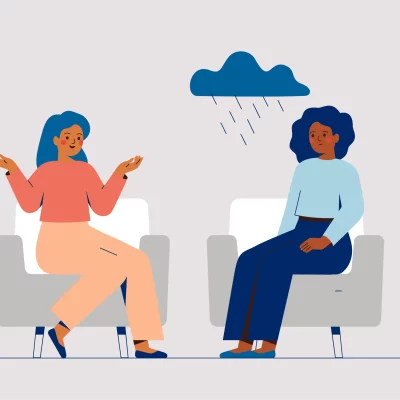Are you feeling lonely?
Do you often feel disconnected from others or find engaging in meaningful conversations challenging?
If so, you may be experiencing social anhedonia – a condition characterized by decreased pleasure and enjoyment while interacting with others.
Social anhedonia is an increasingly common phenomenon affecting millions of people worldwide. It can lead to feelings of isolation and loneliness, ultimately affecting your mental health.
In this blog post, we’ll explore social anhedonia – what it is, what causes it, and how you can overcome it. We’ll also discuss the importance of recognizing the signs of social anhedonia so that you can take steps to improve your mental health. Finally, we’ll review five simple steps you can take to help reduce the effects of social anhedonia and increase your social connection.
What is Anhedonia?
Anhedonia is an inability to experience pleasure from activities that are typically pleasurable. It’s a psychological condition that often goes hand in hand with depression, anxiety, and other mental health issues such as bipolar disorder.
There are two main categories of anhedonia: physical anhedonia (the inability to experience physical pleasure) and social anhedonia (the inability to experience emotional joy). In this post, we will focus on social anhedonia.
Social anhedonia is a state of loneliness due to the lack of meaningful connections with people. It makes it difficult for someone to develop relationships and may lead them to feel isolated, especially if they have difficulty expressing themselves or connecting with others. The condition can even make it challenging to experience positive emotions or enjoy the activities that usually bring people joy.
Signs of social anhedonia include:
- Having difficulty developing relationships
- Feeling isolated from others and not having meaningful connections with people
- Difficulty in expressing emotions or feelings
- Fear or anxiety when faced with social situations
- Uncomfortable interacting with other people, even if they’re familiar
- Being withdrawn from friends and family
- Avoiding social activities altogether
Although they may find it difficult to experience positive emotions with people or fun activities, people with social anhedonia do experience deep emotions.
Someone with social anhedonia can typically feel:
- Unhappiness
- Loneliness
- Anxiety
- Stress
- Low self-esteem
- Depression
So, someone with this condition does not experience the absence of emotions like one would with sociopathy. But they experience certain emotions more often than others.
Causes of Social Anhedonia
The exact causes of social anhedonia are still unknown. However, there are a few potential explanations for why someone might experience this condition.
Some research suggests that people with social anhedonia may have difficulty processing other people’s emotions. This means they struggle to recognize and respond to the emotional cues of those around them, making it difficult for them to form meaningful relationships.
It’s also thought that social anhedonia can be genetic, as some studies indicate a correlation between the condition and specific genes. Additionally, environmental factors may contribute to its development, such as stressful life events or abuse in childhood.
Speaking with a mental health professional to help identify potential causes and triggers to create the most effective treatment plan can play a significant part in diagnosing and recovering from this condition.
Examples:
The following are a few examples of what social anhedonia may look like. As with most mental health conditions, what you experience may differ from what someone else experiences. In these examples, we have included what typical social anhedonia may look like.
Example 1:
John is a 20-year-old college student. He dreads being around others, often feeling overwhelmed and anxious in social situations. Even when surrounded by friends, John prefers to stay quiet and avoid participating in conversations. When his peers try to engage him, John gives one-word answers and quickly leaves the conversation. The stress from social interactions has caused him to have anxiety attacks, which makes the dread of social occasions even heavier.
Example 2:
Samantha is a 40-year-old single mother. She tries her best to go out and socialize with friends but always finds herself withdrawing from conversations and activities. Even though she loves spending time with other people, she finds it difficult to make meaningful connections. This has dramatically affected her self-esteem, making putting herself out socially even more difficult.
Example 3:
Molly is a 70-year-old retiree. She used to love going out and meeting new people, but now she finds it difficult to leave her house. Molly longs for the companionship of others but is too afraid that she won’t be able to make a connection. She often feels isolated in her home and struggles to find joy in activities she used to love. The loneliness she feels has caused her to become significantly depressed.
Do you relate to any of these examples? Can you pick bits and pieces from each example that relate to your experience?
Coexisting Conditions
Some conditions often appear with social anhedonia. These include:
- Anxiety disorders
- Depressive disorders
- Schizophrenia
- Attention Deficit Hyperactivity Disorder (ADHD)
- Autistic Spectrum Disorders
- Substance Use Disorders
According to The National Institutes of Health, over half of patients diagnosed with bipolar disorder experience significant levels of anhedonia during a depressive episode. In addition, nearly 75% of those with major depressive disorder also reported anhedonic symptoms.
Many of the above conditions can coexist with social anhedonia and are not mutually exclusive. If you have symptoms or a diagnosis of any of the listed conditions and think you are also experiencing social anhedonia, it’s essential to speak with a mental health professional for proper diagnosis and treatment.
Treatment Options
There are a few treatment options for social anhedonia, and it’s important to discuss with your doctor or mental health professional which one would be the best fit for you. Often, utilizing more than one treatment option can mean better results.
Here are some treatment options and lifestyle learning that may help in managing this condition:
Talk Therapy
Speaking with a therapist can provide coping strategies to manage the feelings of loneliness and anxiety associated with social anhedonia. A therapist can also help you develop a plan for engaging in social activities or assist with recognizing feelings that may be causing discomfort.
Cognitive Behavioral Therapy
Cognitive behavioral therapy (CBT) is a form of talk therapy used to target unhealthy thinking and behavior patterns and reframe them to be more empowering and positive. In this type of therapy, you will identify and challenge any negative thoughts or beliefs you may have, as well as provide strategies for managing stress and anxiety.
Mindfulness Meditation
Mindfulness meditation can be a valuable tool in dealing with social anhedonia by helping to reduce stress and increase awareness of feelings. Regular practice has been shown to improve attention, reduce rumination, and increase emotional control. If you start social situations calmly, the result is a more positive, less stressful experience.
Medication
Sometimes, when symptoms become overwhelming, medication may be used as part of an effective treatment plan. This includes medications that can help reduce anxiety or depression, as well as medications that may improve your emotional response. It’s important to discuss these options with your doctor or therapist, including realistic results, side effects, and duration of treatment necessary.
Nurturing Relationships
Focus on strengthening existing relationships by engaging in meaningful activities or conversations with those you trust. A strong support network is essential for feeling connected and managing the symptoms of social anhedonia. If you invest time into your relationships, you may experience fewer symptoms during social outings. Because of decreased symptoms, you may increase your ability to enjoy them.
Social Skills Training
Social skills training may assist in developing essential skills like communication, conflict resolution, and empathy. These can help increase your confidence when engaging with others and reduce anxiety associated with social situations.
How to Overcome Social Anhedonia?
This condition is highly treatable, so have hope that things won’t always be this way. By following these steps, you can start on your path toward overcoming social anhedonia and living a more fulfilling life.
5 Steps to Overcome Social Anhedonia:
- Acknowledge your feelings: Take time to recognize the emotions you’re feeling in a non-judgmental way. This will help you understand what is causing or triggering your social anhedonia and how to address it best.
- Set manageable goals: Create small, achievable goals to help you build confidence in yourself and your ability to make meaningful connections. The process starts when you step out of your comfort zone, but you can still have limitations. Small steps toward your goal of enjoying social interactions will make a big difference over time.
- Find ways to relax: Identify activities that reduce stress and help you feel grounded before social situations, such as mindfulness meditation, calming music, or exercise. Using a part of your self-care routine before a social event can help you feel confident and at ease enough to enjoy the occasion.
- Surround yourself with positive people: Be sure to spend time with people who understand and accept you for who you are so that there is less pressure when interacting with them.
- Reach out for help: If you’re overwhelmed, don’t hesitate to contact a mental health professional or trusted friend for additional support and guidance. This condition can make you feel isolated, but reaching out to others and having them show up for you is an integral part of the healing process.
By following these steps, you can start on your path toward overcoming social anhedonia and living a more fulfilling life. Remember to be kind to yourself during this process. Everyone has unique experiences, so be easy on yourself if progress isn’t immediate. Little by little, you can find ways to feel more connected and at ease in social situations.
Conclusion
Social anhedonia can be a complex condition to deal with. Still, it is possible to make progress in managing your symptoms. The first step is often recognizing that you have the condition and understanding what strategies may help to ease it. This could include talking to a therapist, practicing mindfulness meditation, or engaging in social skills training.
Once you recognize and manage your triggers better, you can start engaging with others more confidently and freely. It is essential to take small steps to avoid feeling overwhelmed.
It is also important to know that working through the root causes of your condition may take some time, so go at your own pace and know that the small changes you make each day will amount to major progress. With a combination of treatment options and self-care, you can learn to manage your social anhedonia and find joy in connecting with others.
Try setting small goals for yourself, such as joining a club or activity you enjoy, attending parties or events with friends, or even just saying hello to someone new each day. With each step, you’ll be closer to managing your social anhedonia.
If you are interested in treatment options or want to talk to a licensed therapist who can help you create an effective treatment plan, call us or schedule an appointment here. Our counselors specialize in social disorders and can equip you with tools and coping strategies to overcome what has been holding you back from genuine connection with others.








